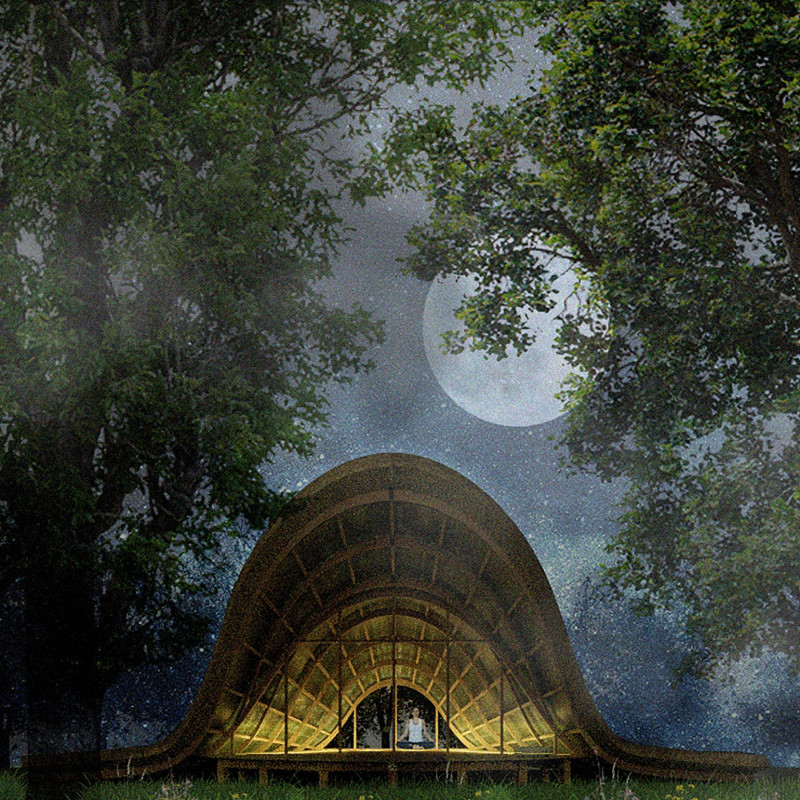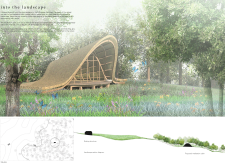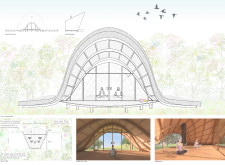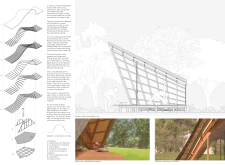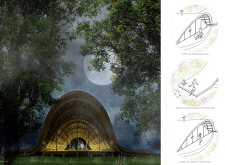5 key facts about this project
At its core, the cabin captures the essence of organic architecture. Its unique form features gentle curves that mimic natural shapes, creating a harmonious dialogue between the building and its environment. This design approach reflects a commitment to creating structures that do not impose on their surroundings but instead enhance them. The use of local materials further accentuates this relationship, reducing the carbon footprint of the project and ensuring it is sympathetic to the locale.
Key components of the cabin include a timber frame that offers structural integrity while allowing for an open, spacious interior. The geometry of the structure allows for expansive glass openings that flood the interior with natural light, creating a sense of openness and inviting the beauty of the surrounding landscape inside. These large windows also provide unobstructed views, encouraging occupants to engage with the scenery, whether during periods of quiet contemplation or social interaction.
The choice of materials is thoughtful and intentional. Timber serves not only as the primary structural element but also as a means of connecting occupants with the warmth and tranquility of the natural world. Complementing this, thatching is employed in the roofing, providing insulation and a tactile experience that recalls traditional building methods. Additionally, the use of reclaimed wood signifies a commitment to sustainability, resonating with the environmental ethos of the sanctuary.
Unique design approaches are evident in the cabin's roof, which overhangs the building to create shaded outdoor areas for activities. This feature effectively extends the usable space into the surrounding environment, allowing for outdoor meditation sessions, communal gatherings, and opportunities for individuals to immerse themselves in nature during warmer months. The cabin's design inherently encourages users to interact with their surrounding environment while maintaining the privacy necessary for personal reflection.
Another notable aspect of this architecture lies in its sensory engagement. The integration of various textures and materials invites occupants to experience the space not only visually but also through touch and sound. The ambiance created during daytime and nighttime enhances the overall user experience, with strategically placed lighting that illuminates the cabin in a way that highlights its architectural features while offering a serene atmosphere during evening activities.
This meditation cabin exemplifies a comprehensive understanding of architecture focused on its impact on human experience and well-being. By successfully balancing functional needs with environmental stewardship, the project embodies a forward-thinking approach that resonates with contemporary architectural ideals. It extends an invitation to individuals seeking respite from the demands of daily life, encouraging exploration of mindfulness and connection with nature.
For those interested in delving deeper into this architectural project, reviewing the architectural plans, sections, designs, and accompanying ideas can provide valuable insights into its thoughtful construction and design philosophy. Exploring these elements will enhance understanding of how this meditation cabin not only serves its immediate programmatic functions but also contributes to the broader discourse on sustainable architecture and mindful living.


